Embarking on a gastronomic journey through the vivid tapestry of Indian cuisine, we find ourselves at the crossroads of two culinary titans—Chicken Korma and Chicken Vindaloo. The mere mention of these dishes is enough to evoke a symphony of flavors, each telling a unique tale of tradition, spice, and indulgence.
In this culinary showdown, we’ll explore the distinct personalities of Korma and Vindaloo, decoding their flavors, uncovering their origins, and guiding you through a delightful exploration of Indian culinary artistry.
So, tighten your apron strings, dear readers, as we delve into the vibrant world of Chicken Korma vs Chicken Vindaloo!
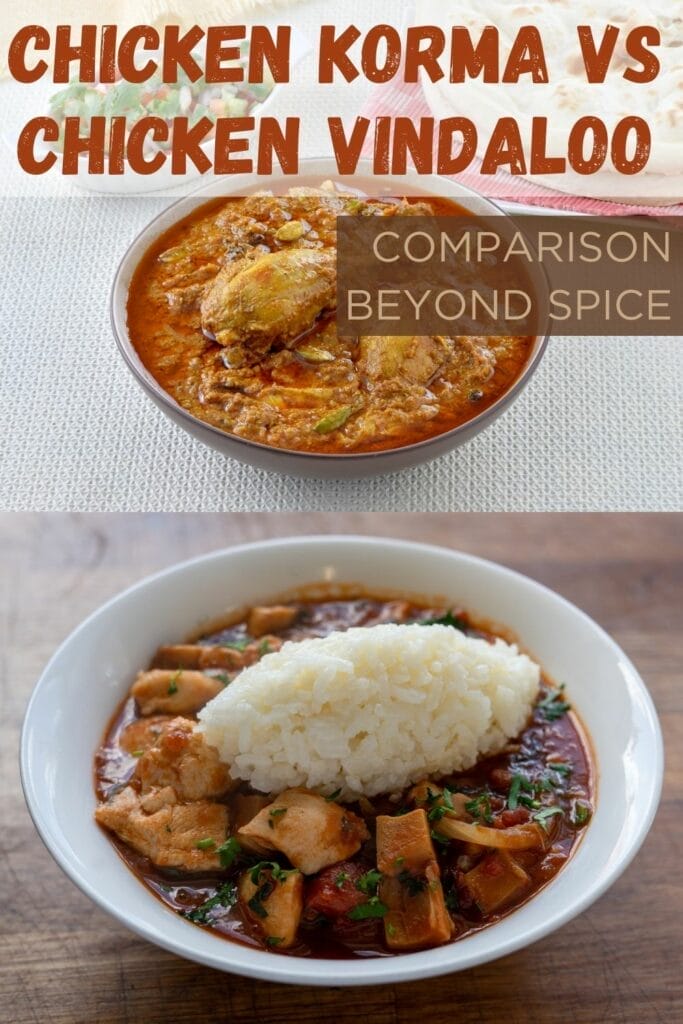
Table showing differences between Chicken korma and chicken vindaloo
| Factor | Chicken Korma | Chicken Vindaloo |
|---|---|---|
| Origin | Mughal cuisine, North India | Goan cuisine, influenced by Portuguese flavors |
| Color | Creamy, ivory | Rich reddish-brown |
| Flavor | Mild, nuanced, and slightly sweet | Bold, spicy, and tangy |
| Chicken Used | Boneless | Bone-in |
| Texture | Velvety and smooth | Robust and hearty |
| Cooking Time | Slow-cooked for tenderness | Slow-cooked for flavor development |
| Method of Cooking | Marinated in yogurt and slow-cooked | Marinated in vinegar and spices, slow-cooked |
| Serving | Elegant presentation in a bowl | Hearty presentation in a deep dish |
| Ingredients | Mild spices, nuts, yogurt, and cream | Intense spices, vinegar, garlic, and mustard seeds |
| Nutritional Value (per serving) | Calories: 300-400 | Calories: 250-350 |
| Protein: 20-25g | Protein: 20-25g | |
| Carbohydrates: 15-20g | Carbohydrates: 10-15g | |
| Fiber: 2-4g | Fiber: 3-5g |
A Brief Overview of Chicken Korma

Chicken Korma, a delightful and aromatic dish, is a gem in the world of Indian cuisine. Let’s dive into the luscious details of this classic that has found its way into the hearts (and stomachs) of food enthusiasts around the globe.
Origins and Heritage
Chicken Korma has its roots deeply embedded in the culinary traditions of the Indian subcontinent. Originating from the Mughlai cuisine, it boasts a rich history dating back to the Mughal era. The Mughals, known for their opulent taste in food, brought forth this dish characterized by its creamy texture and a symphony of spices.
Flavor Profile
One of the distinguishing features of Chicken Korma is its mild and luxurious flavor profile. Unlike its spicier counterparts, this dish is a celebration of subtle tastes. The combination of yogurt, cream, and a melange of aromatic spices creates a velvety sauce that envelops tender chicken pieces, resulting in a dish that’s both comforting and indulgent.
Signature Ingredients
The magic of Chicken Korma lies in its carefully selected ingredients. Cashews and almonds contribute to the creamy texture, while aromatic spices such as cardamom, cloves, and cinnamon add depth to the flavor. The use of yogurt not only tenderizes the chicken but also imparts a subtle tanginess that complements the overall taste.
Preparation Method
Preparing Chicken Korma is an art that requires patience and precision. The chicken is marinated in a blend of yogurt and spices, allowing it to absorb the flavors. The dish is then slow-cooked to perfection, allowing the spices to meld and infuse the chicken with their essence. The addition of cream towards the end provides the final touch, creating a silky and sumptuous gravy.
Serving Suggestions
Chicken Korma is often served with fragrant basmati rice or Indian bread like naan or roti. The mildness of the dish makes it an excellent choice for those who prefer a less spicy yet flavorful dining experience. Garnished with chopped cilantro or toasted nuts, the presentation of Chicken Korma is as enticing as its taste.
In conclusion, Chicken Korma is a culinary masterpiece that encapsulates the essence of Mughlai cuisine. Its mild yet complex flavors make it a favorite for those seeking a luxurious and satisfying dining experience. Whether you’re a seasoned enthusiast of Indian cuisine or a newcomer eager to explore new flavors, Chicken Korma is a dish that promises a delightful journey for your taste buds.
A Brief Overview of Chicken Vindaloo
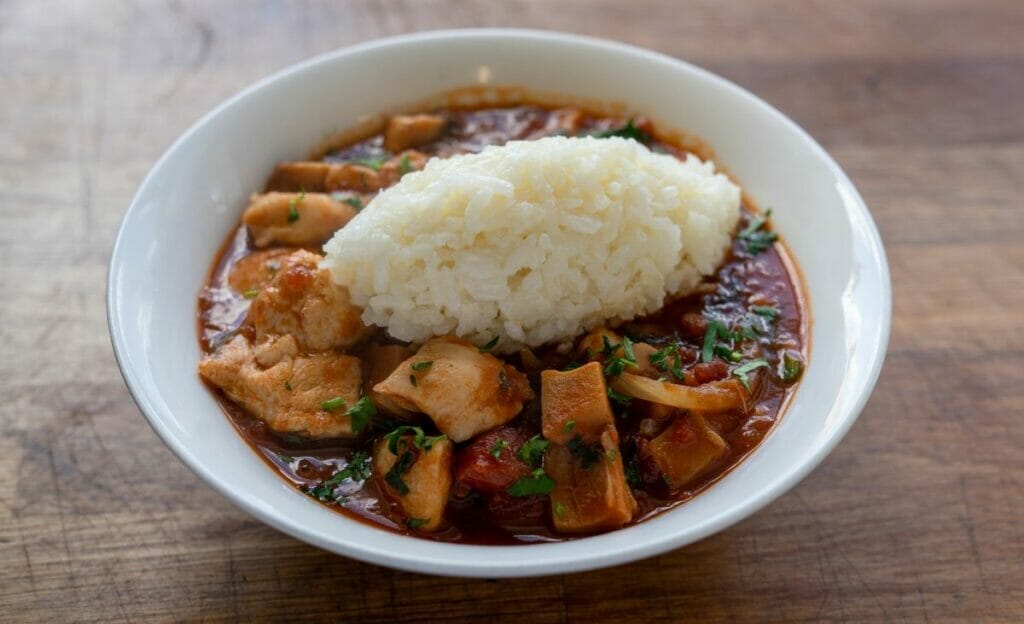
Let’s embark on a flavorful journey exploring the tantalizing world of Chicken Vindaloo—a dish that packs a punch and leaves taste buds tingling with its bold and spicy personality.
A Spicy Affair
Chicken Vindaloo hails from the sunny shores of Goa, India, and boasts a culinary legacy deeply influenced by Portuguese flavors. The name itself is a testament to its unique blend of spices. “Vindaloo” is derived from the Portuguese dish “Carne de Vinha d’Alhos,” where “vinha” refers to wine and “alhos” to garlic. This fusion of Indian and Portuguese culinary traditions results in a dish known for its fiery kick.
Flavor Explosion
Unlike the milder tones of Chicken Korma, Vindaloo is all about bold and robust flavors. The key to its intense taste lies in the marinade, where a potent mixture of vinegar, garlic, ginger, and an array of spices infuse the chicken with a depth that is both spicy and tangy. The heat level can be adjusted to personal preference, making it a favorite for spice enthusiasts.
Signature Ingredients
The star ingredients in Chicken Vindaloo are the vinegar and the spices. The use of vinegar not only imparts a distinctive tang but also acts as a natural preservative, allowing the dish to develop its flavors over time. Mustard seeds, cumin, and red chilies contribute to the bold and aromatic spice blend that characterizes Vindaloo, creating a symphony of tastes with every bite.
Cooking Technique
Cooking Chicken Vindaloo is a dance of flavors that requires a careful balance. The marinated chicken is slow-cooked, allowing the spices to permeate every inch of the meat. The result is a dish that is not only spicy but also tender and flavorful. The cooking process intensifies the robust character of the spices, creating a dish that is as dynamic as it is delicious.
Pairing Possibilities
Chicken Vindaloo is often paired with rice or Indian bread like naan or paratha. The starch serves as a perfect foil to the bold and spicy nature of the dish. A dollop of cooling yogurt or a side of cucumber salad can provide a refreshing contrast, balancing the heat and enhancing the overall dining experience.
In conclusion, Chicken Vindaloo is a culinary adventure waiting to be explored. Its bold flavors and spicy personality make it a standout dish, perfect for those who crave a thrilling culinary experience. Whether you’re a spice aficionado or someone looking to elevate their taste buds to new heights, Chicken Vindaloo promises a delicious journey filled with vibrant and aromatic delights.
Difference between Chicken Korma and Chicken Vindaloo (Detailed breakdown)
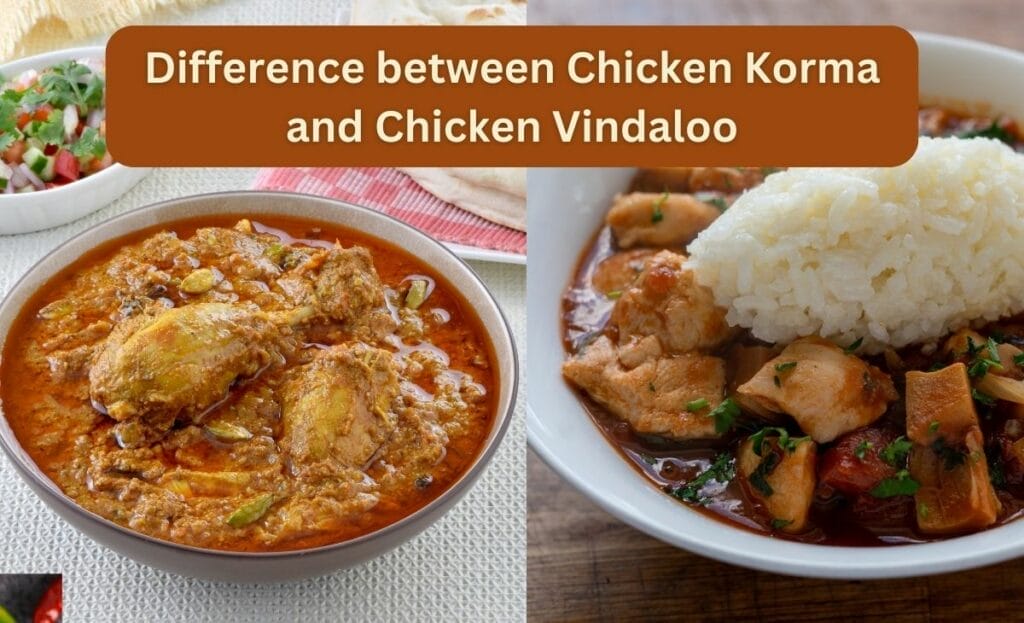
Difference in the Origin
Chicken Korma: Originating from the regal kitchens of the Mughals, Chicken Korma is a dish that whispers tales of opulence and royal feasts. Its roots can be traced back to the Mughal era, showcasing the intricate and refined flavors of North Indian cuisine.
Chicken Vindaloo: On the other hand, Chicken Vindaloo has its origins in the vibrant state of Goa, India. Influenced by Portuguese culinary traditions, Vindaloo brings together the spicy and bold flavors of Indian spices with the tangy twist of vinegar, creating a unique and lively taste.
Differences in Color
Chicken Korma: Picture a plate adorned with a creamy, ivory-colored sauce—the hallmark of Chicken Korma. The dish derives its inviting hue from a harmonious blend of yogurt, cream, and ground nuts, creating a velvety and pale sauce that beckons you to indulge.
Chicken Vindaloo: In stark contrast, Chicken Vindaloo showcases a deep and rich reddish-brown hue. The vibrant color is a result of the fiery combination of red chilies, mustard seeds, and other spices that infuse the dish during the cooking process, promising a visually striking and robust meal.
Differences in Flavor
Chicken Korma: Prepare your taste buds for a journey of subtle indulgence. Chicken Korma is renowned for its mild and luxurious flavor profile. The creaminess of the sauce, coupled with the delicate blend of aromatic spices, results in a dish that is rich, nuanced, and a touch sweet—a true celebration of refined tastes.
Chicken Vindaloo: Brace yourself for a flavor explosion! Chicken Vindaloo is the rebel with a cause, boasting bold and intense flavors. The marriage of vinegar, garlic, and an array of spices creates a dish that is spicy, tangy, and downright exhilarating. It’s a culinary rollercoaster that leaves a lasting impression on your taste buds.
Difference Between the Chicken Used
Chicken Korma: Delve into the world of tenderness. Chicken Korma traditionally features boneless chicken pieces, ensuring a succulent and melt-in-your-mouth texture. The marination process, coupled with slow cooking, transforms the chicken into a heavenly concoction that effortlessly absorbs the flavors of the creamy sauce.
Chicken Vindaloo: Embrace the heartiness. Chicken Vindaloo often utilizes bone-in chicken pieces. This not only adds depth to the dish but also allows the bones to contribute to the overall flavor during the slow-cooking process. The result is a robust and flavorful chicken, perfectly complementing the boldness of the Vindaloo spices.
In essence, the differences between Chicken Korma and Chicken Vindaloo go beyond the surface, revealing the diverse culinary landscapes of India. Whether you lean towards the mild elegance of Korma or crave the fiery intensity of Vindaloo, these dishes offer a delicious exploration of flavors that cater to every palate.
Difference in Texture
Chicken Korma: Picture a bite that’s like a gentle hug for your taste buds. Chicken Korma boasts a velvety and smooth texture, thanks to the combination of yogurt and cream in its sauce. The slow-cooking process ensures that the chicken becomes incredibly tender, offering a melt-in-your-mouth experience that defines indulgence.
Chicken Vindaloo: Get ready for a texture adventure! Chicken Vindaloo, with its bold flavors, presents a more robust and hearty texture. The slow-cooked bone-in chicken allows the dish to develop a substantial mouthfeel. The spices infuse not only the flavor but also the very essence of the meat, resulting in a dish that’s as satisfying in texture as it is in taste.
Difference in Cooking Time
Chicken Korma: Patience is the key when crafting the perfect Chicken Korma. The slow-cooking process is a labor of love, allowing the chicken to absorb the myriad of flavors in the marinade. The result is a dish that’s worth the wait—a luxurious and tender masterpiece that showcases the artistry of Indian cuisine.
Chicken Vindaloo: In the realm of Vindaloo, time is still a crucial ingredient, but with a different purpose. The longer cooking time is needed to allow the bold spices to permeate the chicken thoroughly. This slow and steady approach ensures that every bite of Chicken Vindaloo is a burst of intense and harmonized flavors.
Difference in the Method of Cooking
Chicken Korma: The magic of Chicken Korma lies in its meticulous preparation. The chicken is marinated in a blend of yogurt and spices, allowing it to soak up the flavors. The slow-cooking process ensures that each ingredient melds together, resulting in a creamy and nuanced sauce that envelops the tender chicken.
Chicken Vindaloo: Brace yourself for a more dynamic culinary dance. Chicken Vindaloo starts with a punchy marinade of vinegar, garlic, and spices. The bone-in chicken is then slow-cooked, allowing the spices to infuse into the meat. The method is a culinary crescendo, creating a dish that’s not only spicy but also deeply satisfying in its complexity.
In essence, the differences in texture, cooking time, and the method of cooking highlight the unique personalities of Chicken Korma and Chicken Vindaloo. Whether you savor the slow-cooked tenderness of Korma or revel in the robust intensity of Vindaloo, each dish offers a distinct culinary experience that’s sure to leave a lasting impression on your palate.
Difference in the Serving
Chicken Korma: Imagine a regal spread—Chicken Korma is often presented with an air of elegance. Served in a bowl, the creamy sauce blankets the tender chicken, creating a visually appealing dish. Garnishes of chopped cilantro or toasted nuts add a final touch, making it a feast for both the eyes and the palate.
Chicken Vindaloo: Prepare for a vibrant and hearty presentation! Chicken Vindaloo, with its robust flavors, is often served in a deep dish. The reddish-brown sauce clings to the bone-in chicken, creating a visually striking plate. Pair it with a side of rice or bread, and you have a meal that’s not just delicious but also a feast for the senses.
Difference in the Ingredients
Chicken Korma: Enter the world of subtlety and richness. Chicken Korma features a blend of mild spices like cardamom, cloves, and cinnamon. Cashews and almonds contribute to the creamy texture, while yogurt and cream add a touch of tanginess. The result is a harmonious medley of flavors that’s both comforting and luxurious.
Chicken Vindaloo: Brace yourself for a spice explosion! Chicken Vindaloo is bold and fearless, with ingredients like mustard seeds, cumin, and fiery red chilies taking center stage. The distinctive tang comes from a generous use of vinegar, creating a flavor profile that’s intense, spicy, and uniquely vibrant.
Difference in Nutritional Value
Chicken Korma
- Calories: Chicken Korma, with its creamy base, tends to be higher in calories. On average, a serving may contain around 300-400 calories.
- Protein: The dish is a good source of protein, providing approximately 20-25 grams per serving.
- Carbohydrates: With the inclusion of nuts and dairy, Chicken Korma tends to have a moderate amount of carbohydrates, usually around 15-20 grams per serving.
- Fiber: The fiber content is relatively low, ranging from 2-4 grams per serving.
Chicken Vindaloo
- Calories: Chicken Vindaloo, being a spicier dish, can be lower in calories, typically ranging from 250-350 calories per serving.
- Protein: Similar to Korma, Vindaloo is a good source of protein, offering around 20-25 grams per serving.
- Carbohydrates: The dish may have slightly fewer carbohydrates, averaging around 10-15 grams per serving.
- Fiber: The fiber content is also moderate, ranging from 3-5 grams per serving.
In summary, whether you opt for the creamy elegance of Chicken Korma or the bold spiciness of Chicken Vindaloo, each dish brings its own unique charm to the table. From the serving style to the ingredient lineup and nutritional values, these culinary delights cater to diverse tastes and preferences, ensuring a delightful dining experience for every palate.
Are There Any Similarities Between Chicken Korma and Chicken Vindaloo?
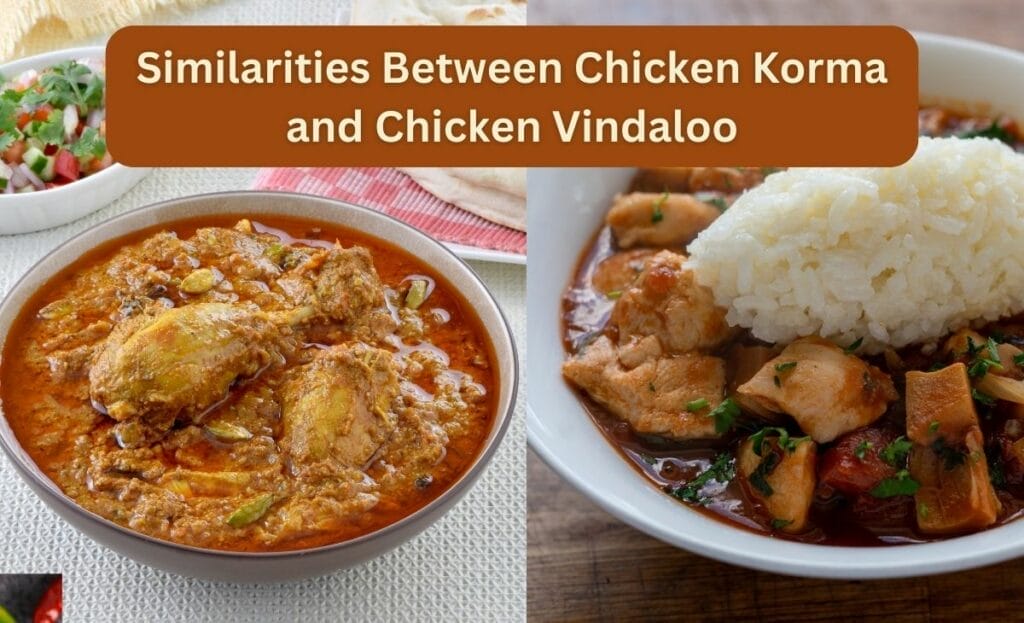
Common Ground in Culinary Heritage
Culinary Roots: Despite their distinct flavors, both Chicken Korma and Chicken Vindaloo share a common origin in the vibrant tapestry of Indian cuisine. Korma, with its roots in Mughal culinary traditions, and Vindaloo, influenced by Portuguese flavors in Goa, showcase the rich diversity that characterizes Indian cooking.
Protein Powerhouses
Chicken as the Star: At the heart of these two dishes is the beloved chicken. Both Korma and Vindaloo feature this versatile meat, albeit prepared in different styles. Whether it’s the slow-cooked tenderness of Korma or the robust, spice-infused Vindaloo, chicken takes center stage in delivering a protein-packed culinary experience.
Spice Palette Diversity
Shared Spice Cabinet: While the intensity of spices may differ, the spice cabinet itself sees some overlap. Both dishes feature aromatic spices like cumin, cardamom, and cloves, albeit in varying proportions. This shared spice palette contributes to the aromatic allure that defines Indian cuisine.
Versatility in Pairings
Perfect Partners: Another similarity lies in their versatility when it comes to accompaniments. Whether paired with fragrant basmati rice or the comforting warmth of naan and roti, both Korma and Vindaloo adapt well to various side dishes, allowing for a personalized dining experience.
Celebration of Slow Cooking
Time-Honored Tradition: Both dishes pay homage to the art of slow cooking. Whether it’s the gradual infusion of flavors in Korma or the slow-cooked amalgamation of spices in Vindaloo, this shared commitment to patient preparation adds a layer of depth and richness to the final culinary offerings.
In conclusion, while Chicken Korma and Chicken Vindaloo stand apart in their taste profiles, they share a common thread in their culinary heritage, protein-rich foundations, spice selection, versatility in pairings, and the time-honored tradition of slow cooking. Exploring the similarities between these two dishes offers a deeper appreciation for the diverse yet interconnected world of Indian cuisine.
How to make Chicken Korma?
How to make Chicken Vindaloo?
FAQ
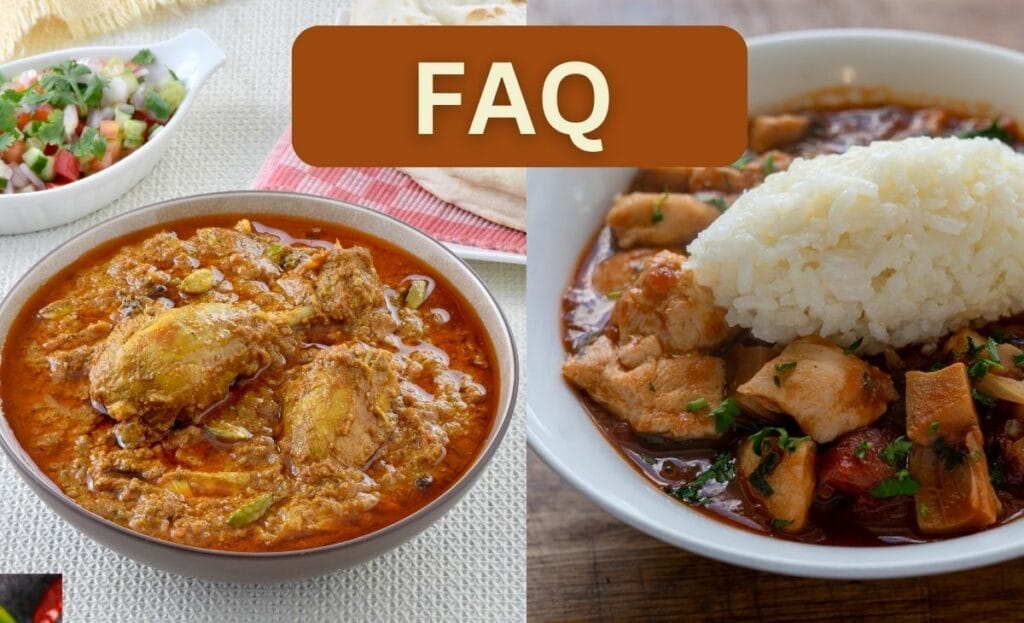
Chicken Korma vs. Chicken Vindaloo: What’s the Difference in Taste
Chicken Korma: Imagine a symphony of subtle flavors dancing on your palate. Chicken Korma is a celebration of mildness, with its creamy sauce, infused with a delicate blend of spices. The taste is nuanced, slightly sweet, and undeniably luxurious. The tender chicken becomes a canvas for the richness of the sauce, resulting in a dish that’s both comforting and indulgent.
Chicken Vindaloo: Brace yourself for a taste explosion! Chicken Vindaloo is the bold rebel in this culinary tale. Its flavor profile is a dynamic mix of intense spices, tanginess from vinegar, and the robust essence of bone-in chicken. The result is a dish that’s spicy, tangy, and exhilarating, offering a taste experience that’s anything but ordinary.
Chicken Korma vs. Chicken Vindaloo: What’s the Difference in Calories
Chicken Korma: Indulgence comes at a calorie cost. Chicken Korma, with its creamy base, tends to be higher in calories, typically ranging from 300 to 400 calories per serving. The richness of nuts, yogurt, and cream contributes to the delicious but calorie-dense nature of this dish.
Chicken Vindaloo: In the realm of spice, there’s a slight reprieve for your calorie count. Chicken Vindaloo, being spicier, often sits in the range of 250 to 350 calories per serving. The focus on bold flavors means you get to enjoy the dish with a slightly lighter calorie load.
Chicken Korma vs. Chicken Vindaloo: What’s the Difference in Nutrition
Chicken Korma: If you’re looking for protein, Chicken Korma delivers, providing around 20-25 grams per serving. However, the dish tends to be moderate in carbohydrates (15-20g) and relatively low in fiber (2-4g).
Chicken Vindaloo: Similar to Korma, Vindaloo is a protein-packed delight, offering around 20-25 grams per serving. With slightly fewer carbohydrates (10-15g) and a moderate fiber content (3-5g), it strikes a balance between bold flavors and nutritional value.
Which is Spicier: Chicken Korma or Chicken Vindaloo?
Chicken Vindaloo takes the spice crown! If you’re a spice enthusiast seeking a fiery adventure, Chicken Vindaloo is your go-to. Its intense blend of red chilies, mustard seeds, and vinegar creates a dish that’s not just spicy but downright thrilling. In contrast, Chicken Korma caters to those who prefer a milder, more delicate taste.
Which is Healthier: Chicken Korma or Chicken Vindaloo?
The healthier choice depends on your preferences and dietary goals. If you prioritize lower calories and enjoy bold, spicy flavors, Chicken Vindaloo might be the better fit. On the other hand, if you lean towards a more indulgent experience with a creamier texture and milder taste, Chicken Korma could be your healthier indulgence.
Which is Better: Chicken Korma or Chicken Vindaloo?
It’s a matter of personal taste! Both Chicken Korma and Chicken Vindaloo bring their unique charm to the table. If you crave richness and subtle flavors, Korma is the winner. If you’re up for a spice-filled adventure and a hearty texture, Vindaloo steals the show. Ultimately, the choice between the two depends on your mood, preferences, and the level of culinary excitement you seek.
In Conclusion: Exploring the Rich Tapestry of Indian Flavors
In the clash of titans between Chicken Korma and Chicken Vindaloo, we’ve delved into a culinary journey that transcends taste buds and embraces the diverse heritage of Indian cuisine. From the opulent elegance of Korma, with its creamy embrace and subtle flavors, to the fiery rebellion of Vindaloo, each dish tells a tale that goes beyond the ingredients.
We uncovered the nuances of their origins, danced through the vibrant colors they bring to the table, savored the diverse flavors that define them, and even delved into the nutritional aspects that cater to different preferences. Whether you’re a fan of the comforting richness of Korma or the bold spice symphony of Vindaloo, there’s a place for you at the Indian dining table.
What’s more, we discovered surprising similarities between these culinary giants—the shared roots, the protein-packed chicken, the aromatic spice cabinet, the versatile pairings, and the dedication to the time-honored tradition of slow cooking.
Now, as you prepare to embark on your own culinary adventure, armed with insights into the taste, calories, nutrition, and more, there’s one thing left to do—grab your apron or head to your favorite Indian restaurant. The world of Chicken Korma and Chicken Vindaloo awaits, promising a gastronomic experience that’s both delightful and diverse.
If you’ve ever wondered which dish aligns with your palate or if the spice fiesta of Vindaloo is calling your name, be sure to read the full article. There’s a wealth of information waiting for you, and perhaps a new culinary favorite just waiting to be discovered. Happy reading and even happier eating!
- Chicken Korma vs Chicken Karahi: A Tale of Two Curries
- Chicken Korma vs Chicken Curry: Diverse Indian Delicacies
- Chicken Tikka Masala vs Chicken Korma (Exploring Indian Cuisine)
- Butter Chicken vs Chicken Korma: A Flavorful Face-Off
- Chicken Tikka Masala vs Chicken Vindaloo (Exploring the Differences)
- Butter Chicken vs. Chicken Vindaloo (Unveiling the Differences)
